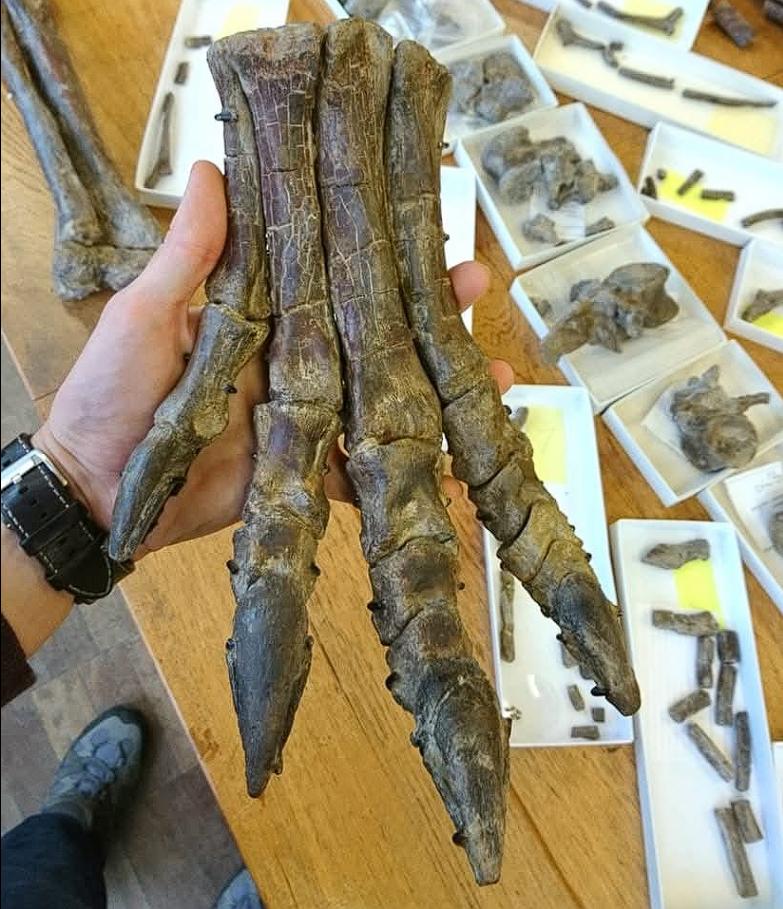“The 1994 discovery in Montana of a fossilized dinosaur foot, part of a remarkably complete Tenontosaurus skeleton, offered humanity another tangible link to a world that existed over 100 million years ago. This gentle herbivore, a denizen of the Cretaceous period, left behind a fossil that serves as an extraordinary window into the vast expanse of deep time, a testament to the power of paleontological science to unearth narratives buried for eons beneath our feet. However, this seemingly straightforward scientific find carries profound implications, particularly when juxtaposed with belief systems that posit a far younger Earth, creating a stark divergence in understanding our planet’s history.”
Unearthing a Cretaceous Giant: A Window into a Lost World
- The Montana Discovery:
- The paleontological excavation in Montana in 1994 was not just the unearthing of a fossil; it was the unveiling of a significant chapter in Earth’s ancient history. The almost complete Tenontosaurus skeleton, with its remarkably preserved foot, provided a tangible connection to a creature that lived over 100 million years ago.
- This discovery underscored the rich fossil record of Montana, a region that has yielded numerous significant dinosaur finds, contributing immensely to our understanding of the Mesozoic Era.
- Tenontosaurus: A Gentle Herbivore:
- The Tenontosaurus, a gentle herbivore that roamed the Earth during the Cretaceous period, offers insights into the diverse ecosystems of that time. Its size and dietary habits paint a picture of a world dominated by massive reptiles, each playing a crucial role in the prehistoric food web.
- Studying fossils like the Tenontosaurus foot allows paleontologists to reconstruct the anatomy, behavior, and evolutionary relationships of these ancient creatures, providing a deeper understanding of life on Earth millions of years ago.
- A Footprint Across Time:
- The fossilized foot is more than just a bone; it is a footprint across the vast expanse of deep time. It represents a moment frozen in geological history, a tangible link to a living creature that inhabited a world long vanished beneath the layers of sediment and rock.
- This single fossil serves as a powerful reminder of the immense timescale of Earth’s history, a timescale that dwarfs human existence and challenges our everyday perceptions of time.
The Power of Paleontology: Unearthing Buried Narratives
- Science and Deep Time:
- The discovery of the Tenontosaurus foot is a testament to the power of paleontological science to unearth stories buried for eons beneath our feet. Through careful excavation, meticulous analysis, and the application of scientific principles, paleontologists can reconstruct ancient ecosystems and the creatures that inhabited them.
- This scientific process relies on radiometric dating, stratigraphy, and comparative anatomy, providing a robust framework for understanding the timeline of Earth’s history and the evolution of life.
- Reconstructing Ancient Worlds:
- Fossils like the Tenontosaurus foot are crucial pieces in the puzzle of reconstructing ancient worlds. They provide direct evidence of the flora and fauna that existed millions of years ago, allowing scientists to piece together the environmental conditions and ecological interactions of these lost ecosystems.
- By studying these remnants of the past, we gain a deeper appreciation for the dynamic nature of our planet and the long and complex history of life on Earth.
- Challenging Human-Centric Views:
- The sheer age of the Tenontosaurus fossil challenges human-centric views of time and the universe. It places human existence within the context of a much larger narrative, one that spans billions of years and encompasses a vast array of life forms that predate our species by unimaginable stretches of time.
- This perspective encourages a sense of humility and a broader understanding of our place within the grand tapestry of Earth’s history.
A Confusing Foot: Divergent Understandings of Earth’s History
- The Young Earth Belief:
- The existence of a 100-million-year-old dinosaur fossil presents a significant challenge to those who adhere to a belief in a young Earth, typically estimated to be around 6,000 years old based on certain interpretations of religious texts.
- This fundamental difference in understanding the timescale of Earth’s history creates a stark divergence in interpreting scientific evidence such as dinosaur fossils.
- Irreconcilable Timelines:
- The scientific evidence for deep time, supported by multiple independent lines of inquiry, stands in stark contrast to the young Earth timeline. Radiometric dating, for example, consistently places the age of dinosaur fossils in the millions of years, a timeframe irreconcilable with a 6,000-year-old Earth.
- This conflict highlights the distinct epistemological frameworks used by science and certain religious beliefs, leading to fundamentally different interpretations of the natural world.
- A Point of Contention:
- For those who believe in a young Earth, a fossilized dinosaur foot dating back 100 million years might indeed be a “very confusing foot.” It challenges a core tenet of their belief system and requires alternative explanations that often fall outside the realm of mainstream scientific understanding.
- This point of contention underscores the importance of open dialogue and respectful engagement between different worldviews, even when fundamental disagreements exist regarding the interpretation of scientific evidence.
Conclusion:
“The fossilized foot of a Tenontosaurus, unearthed from the Montana earth, serves as a powerful symbol of deep time, a tangible link to a world that existed over 100 million years ago. This remarkable discovery underscores the power of paleontological science to unearth the long and complex history of life on Earth. However, it also highlights the divergent understandings of our planet’s history, particularly when confronted with belief systems that posit a far younger Earth. This ‘confusing foot’ becomes a focal point for exploring the contrasting frameworks of scientific inquiry and certain religious interpretations, prompting reflection on our place within the vast expanse of cosmic and geological time.”

CÁC TIN KHÁC
Mary Walton: The Forgotten Inventor Who Helped Clean Up America’s Cities
Tomb of Queen Nefertari in the Valley of the Queens, Egypt
Discover the Hypostyle Hall of the Temple of Hathor at Dendera
Venus de Losange: Unveiling the Mystery of a 20,000-Year-Old Paleolithic Icon